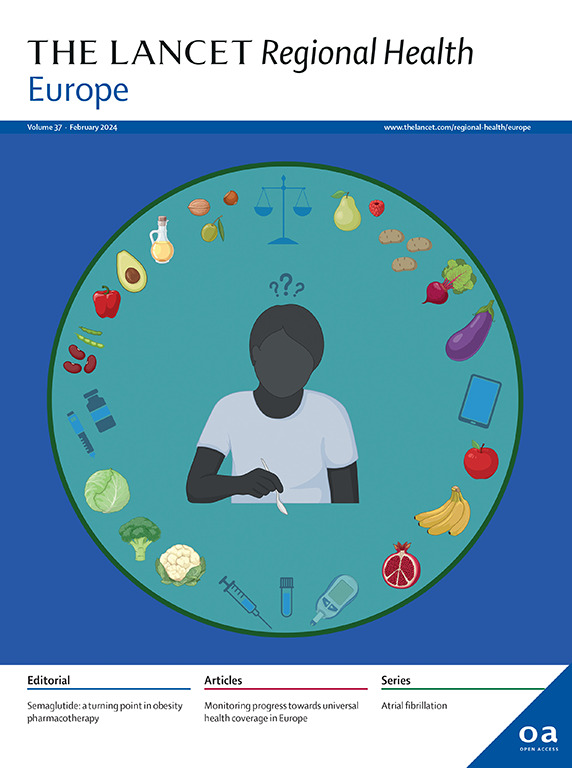Health outcomes up to 3 years and post-exertional malaise in patients after hospitalization for COVID-19: a multicentre prospective cohort study (CO-FLOW)
IF 13.6
Q1 HEALTH CARE SCIENCES & SERVICES
引用次数: 0
Abstract
Background
Many patients experience long-lasting health problems after COVID-19. The study aimed to assess 3-year trajectories of a comprehensive set of patient-reported outcome measures (PROMs) in patients hospitalized for COVID-19, particularly focusing on the 2- to 3-year trajectory. Additionally, we evaluated prevalence of post-exertional malaise (PEM) at 3 years, its risk factors, co-occurring health problems, and the 3-year trajectories of patients with and without PEM.
Methods
The CO-FLOW multicentre prospective cohort study followed up adults hospitalized for COVID-19 in 7 hospitals, located in the Netherlands. Study assessments were performed at 3, 6, 12, 24, and 36 months post-discharge, conducted between July 1, 2020, and May 22, 2024. PROMs on recovery, symptoms, fatigue, mental health, cognition, participation, sleep quality, work status, health-related quality of life (HRQoL), and PEM were collected. Generalized estimating equations were used to assess health trajectories and multivariable logistic regression to identify risk factors for PEM.
Findings
In total, 299/344 (87%) patients completed the 3-year follow-up and were included in the analysis. Complete recovery rates increased (p < 0.001), from 12% at 3 months to 24% at 3 years. Symptoms of impaired fitness, fatigue, and muscle weakness (all p < 0.0019) and PROMs for fatigue score, participation, return to work, and HRQoL (all p < 0.005) improved significantly over time, while PROMs for cognitive failures worsened (p < 0.001). Between the 2- and 3-year visits, memory problems (OR 1.4 [1.1–1.7], p < 0.001), and scores of fatigue (MD +1.0 [0.4–1.6], p = 0.002), cognitive failures (MD +2.2 [0.9–3.4], p < 0.001), and SF-36 mental component summary (−2.2 [−3.1 to −1.3], p < 0.001) significantly worsened. At 3 years, 66% of patients experienced fatigue, 63% impaired fitness, 59% memory problems, and 53% concentration problems. PROMs showed that 62% reported poor sleep quality, 55% fatigue, and 28% cognitive failures. PEM was reported by 105/292 (36%) patients at 3 years; risk factors were female sex (OR 3.4 [95% CI 1.9–6.0], p < 0.001), pre-existing pulmonary disease (3.0 [1.7–5.6], p < 0.001), physical inactivity pre-COVID-19 (2.3 [1.2–4.1], p = 0.008), and ICU treatment for COVID-19 (1.8 [1.02–3.0], p = 0.04). Concurrent fatigue, cognitive failures, and dyspnea were more common in patients with (42%) than without (6%) PEM. Patients with PEM showed poor health outcomes throughout the entire follow-up period, including worsening fatigue and HRQoL during the third year.
Interpretation
Many health problems persisted up to 3 years post-discharge, with self-reported fatigue and cognitive problems worsening in the third year. PEM was common, and linked to a more severe phenotype of long COVID. These findings highlight the urgent need to optimize treatment options and investigate underlying pathological mechanisms of COVID-19.
Funding
The Netherlands Organisation for Health Research and Development (ZonMw); Rijndam Rehabilitation; Laurens.
COVID-19住院患者长达3年的健康状况和运动后不适:一项多中心前瞻性队列研究(CO-FLOW)
许多患者在COVID-19后经历了长期的健康问题。该研究旨在评估因COVID-19住院患者的一套全面的患者报告结果测量(PROMs)的3年轨迹,特别关注2至3年的轨迹。此外,我们评估了3年后运动后不适(PEM)的患病率,其危险因素,共同发生的健康问题,以及有和没有PEM的患者的3年轨迹。方法CO-FLOW多中心前瞻性队列研究对荷兰7家医院因COVID-19住院的成年人进行随访。研究评估于2020年7月1日至2024年5月22日期间在出院后3、6、12、24和36个月进行。收集康复、症状、疲劳、心理健康、认知、参与、睡眠质量、工作状态、健康相关生活质量(HRQoL)和PEM方面的prom。使用广义估计方程来评估健康轨迹,并使用多变量逻辑回归来确定PEM的危险因素。344例患者中有299例(87%)完成了为期3年的随访并纳入分析。完全采收率提高(p <;0.001), 3个月时为12%,3年时为24%。健康受损、疲劳和肌肉无力的症状(都是p <;0.0019)和疲劳评分、参与、重返工作和HRQoL的PROMs (p <;0.005)随着时间的推移显著改善,而认知失败的prom恶化(p <;0.001)。在2年和3年随访期间,记忆问题(OR 1.4 [1.1-1.7], p <;0.001),疲劳评分(MD +1.0 [0.4-1.6], p = 0.002),认知失败评分(MD +2.2 [0.9-3.4], p <;0.001), SF-36心理成分总结(- 2.2[- 3.1至- 1.3],p <;0.001)显著恶化。3年后,66%的患者出现疲劳、63%的健康受损、59%的记忆问题和53%的注意力问题。prom显示,62%的人睡眠质量差,55%的人疲劳,28%的人认知障碍。3年时,有105/292例(36%)患者报告了PEM;危险因素为女性(OR 3.4 [95% CI 1.9 ~ 6.0], p <;0.001),既往肺部疾病(3.0 [1.7-5.6],p <;0.001)、COVID-19前缺乏身体活动(2.3 [1.2-4.1],p = 0.008)和COVID-19 ICU治疗(1.8 [1.02-3.0],p = 0.04)。并发疲劳、认知失败和呼吸困难在PEM患者中(42%)比无PEM患者(6%)更常见。PEM患者在整个随访期间表现出较差的健康状况,包括第三年期间疲劳和HRQoL恶化。许多健康问题在出院后持续3年,自我报告的疲劳和认知问题在第三年恶化。PEM很常见,与更严重的长冠状病毒表型有关。这些发现突出了优化治疗方案和研究COVID-19潜在病理机制的迫切需要。资助荷兰卫生研究与发展组织(卫生研究与发展组织);Rijndam康复;劳伦斯。
本文章由计算机程序翻译,如有差异,请以英文原文为准。
求助全文
约1分钟内获得全文
求助全文
来源期刊

Lancet Regional Health-Europe
Multiple-
CiteScore
19.90
自引率
1.40%
发文量
260
审稿时长
9 weeks
期刊介绍:
The Lancet Regional Health – Europe, a gold open access journal, is part of The Lancet's global effort to promote healthcare quality and accessibility worldwide. It focuses on advancing clinical practice and health policy in the European region to enhance health outcomes. The journal publishes high-quality original research advocating changes in clinical practice and health policy. It also includes reviews, commentaries, and opinion pieces on regional health topics, such as infection and disease prevention, healthy aging, and reducing health disparities.
 求助内容:
求助内容: 应助结果提醒方式:
应助结果提醒方式:


